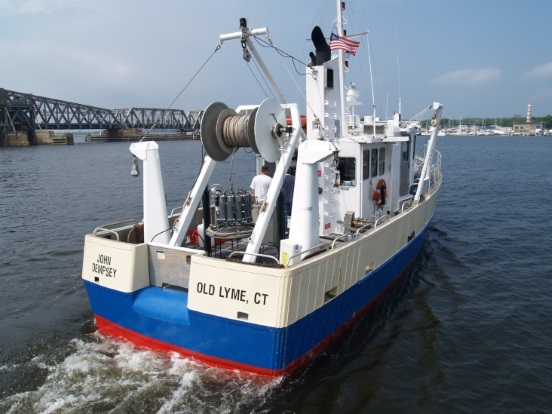Long Island Sound Water Quality and Hypoxia Monitoring Program
The CT DEEP Water Monitoring Program, on behalf of the Long Island Sound Partnership, performs an intensive year-round water quality monitoring program on Long Island Sound. The data collected are used to understand the current conditions and changes in water quality. DEEP is particularly interested in better understanding the effects of hypoxia on the water quality and the biology of the Sound.

Program Overview
Since 1991, CT DEEP has conducted an intensive year-round water quality monitoring program on Long Island Sound. From October to May, in situ data and nutrient samples are collected once a month from 17 sites. Data from the surveys are used to quantify and identify annual trends and differences in water quality parameters relevant to hypoxia (low dissolved oxygen), especially nutrients, temperature, and chlorophyll. These data are also used to evaluate the effectiveness of the management program to reduce nitrogen concentrations.
During the summer (June -September) CT DEEP conducts additional summer hypoxia surveys at bi-weekly intervals to better define the areal extent and duration of hypoxia. During these surveys up to 48 stations are sampled for in situ parameters including dissolved oxygen, temperature, pH, and salinity. Surface and bottom water samples are also collected and sent to a laboratory for analysis.
Since 2002, CT DEEP has collected zooplankton samples from 6 stations and phytoplankton from 10 stations across Long Island Sound. The samples are sent to researchers at the University of Connecticut who identify species composition, abundance, community structure, and spatial and temporal distribution throughout the Sound.
All samples are collected and analyzed under EPA-approved Quality Assurance Project Plans.
Annual Summer Hypoxia Monitoring Reports
Hypoxia is a condition of low dissolved oxygen concentrations in the waters of Long Island Sound that impacts up to half of the Sound’s waters each summer. The primary cause of hypoxia is nitrogen enrichment that comes from a variety of sources throughout the Long Island Sound watershed, in particular sewage treatment plants, stormwater runoff and atmospheric deposition. The nitrogen stimulates the growth of phytoplankton, microscopic plants that grow in the Sound. Today, so much nitrogen has been added that the amount of phytoplankton generated causes low oxygen in the summer when it decays in the bottom waters.
Below are annual summary reports of the Long Island Sound Hypoxia Season Review - Summer Water Quality Monitoring Program. Click on any one of these report links to view detailed data and narrative information of water quality conditions for the summer. Note that reports published since 2016 are joint reports produced by CT DEEP in collaboration with the Interstate Environmental Commission (IEC).
Learn More...
Fact Sheets
Related DEEP Webpages
- Connecticut's Coastal Nonpoint Source Pollution Control Program
- Connecticut's No Discharge Area Program
Partner Websites
- Long Island Sound Partnership
- National Centers for Coastal Ocean Science (NCCOS) Hypoxia Program
- NOAA Ocean Acidification Program
- UConn Long Island Sound Integrated Coastal Observing System (LISICOS)
- Interstate Environmental Commission (IEC)
For Additional Information Contact:
Mary Becker
Water Monitoring and Assessment Program
79 Elm Street, Hartford CT 06106
860-424-3262
mary.becker@ct.gov
Content last updated October 2025

